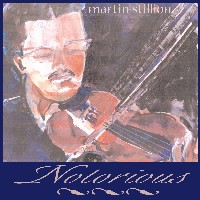Review: Terry Bales electric mandolin
 Sometimes the pursuit of electric mandolins makes me feel a bit like a cryptozoologist—you know, those folks who spend their lives tramping around the globe in pursuit of undocumented animal species. There are times when I'm not sure whether a particular instrument is an okapi—something that exists, but is just hard to find—or a Bigfoot—something that in all likelihood resides only in the realm of legend and hoax.
Sometimes the pursuit of electric mandolins makes me feel a bit like a cryptozoologist—you know, those folks who spend their lives tramping around the globe in pursuit of undocumented animal species. There are times when I'm not sure whether a particular instrument is an okapi—something that exists, but is just hard to find—or a Bigfoot—something that in all likelihood resides only in the realm of legend and hoax.But I'm happy to report that the case of Eldorado Springs, Missouri luthier Terry Bales has now been resolved: Most definitely an okapi. And worth tracking down. In all my years of hunting electric mandolins, I have seen a secondhand Bales for sale only once—which suggests that the owners of these instruments know they've got a good thing and aren't about to let it go.
Terry's had some periods of inactivity over the past few years—which only adds to the mystique—but currently is tooled up and building his excellent semi-hollow electrics. The one he sent is a 4-string mandolin; he also builds mandola-scale instruments and will add a 5th string if requested.
In terms of styling and appearance, there's a strong Fender influence on Terry's work, but this mandolin—with its single cutaway, F-hole, and 1 7/8" body depth—seems to draw as much from the Thinline Telecaster guitar as from the Mandocaster. The chambered body is carved from a mahogany block; the top is bookmatched spalted maple in its natural color, with just a light stain applied to enhance the grain. The bolt-on neck is natural curly maple. There's a 3-ply tortoiseshell plastic pickguard, and a rosewood fretboard with "small guitar" frets—about the same size as banjo fretwire, i.e., bigger than standard mandolin frets but smaller than standard guitar frets. The pickup is a GFS Fatboy dual rail humbucker. Nickel hardware includes a through-body bridge, tone & volume controls, individual Grover tuners, and a nifty roller-style string tree. The instrument comes in a Superior padded gig bag.
At 1 3/16", the nut is just a hair on the wide side, which allows Terry to open up the string spacing a little. It's a noticeable difference from the spacing I'm accustomed to, but once my left hand adjusted, I found that it allows for clean picking and some magnificent string-bending opportunities. And if you want to try some fingerstyle mandolin playing, this might be the instrument for you.
Many e-mandos with twin-rail pickups have a coil-splitting switch of some kind, enabling the player to pull different tones from the pickup by changing the wiring. This one doesn't—that's the bad news. The good news is that the pickup sounds magnificent anyhow, and the mandolin is remarkably feedback-resistant for a hollow instrument. At moderate volume levels you get a "clean" tone suitable for country or Delta blues, but if you crank the pickup into overdrive, you can play electric blues or rock'n'roll without really needing an effects pedal.
The okapi, by the way, is now bred in captivity in Africa and is a fairly common animal to see in larger zoos. Although it was clearly depicted in ancient Egyptian art, it took Westerners about 2,400 years to find and document one. But you needn't wait that long to add a Terry Bales electric mandolin to your menagerie. He reports that his Web site will be back online this summer. Meanwhile, you can find his contact information here, along with more photos.
Overall:





